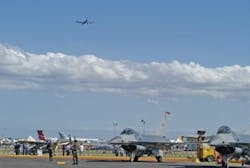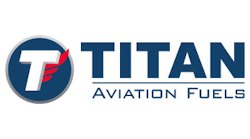The chance to mix work and an obsession with airplanes is just too much for some of our colleagues to resist and they have been known to take time off from their regular job airside to work in this aviation circus - for the fun of it.
The reality is that running the ground support services at an Airshow is just as demanding and exacting as work at any commercial or military airfield.
Fitting into a show schedule that will thrill the paying public and alongside aircrew who have to provide the entertainment is no easy call.
Ground Support Magazine went behind the scenes at Australia's Airshow Downunder last month to meet the people and have a look at what it takes to make such an event happen - on the ground at least.
Where it All Happens
The show is held at Avalon Airport, about 40 minutes by freeway from Melbourne.
Built as an aircraft manufacturing facility in the 1950s, Avalon has recently been rejuvenated as the base for the Qantas budget carrier Jetstar and an annex for Qantas heavy maintenance in Sydney.
It's the Airshow that has put the site on the map. Held every second year the place is buzzing over the three trade show days and two public days. Airshow 2005 clicked more than 200,000 visitors through the turnstiles making one of the world's most popular airshows and the biggest in the Asia Pacific region. With just over 800 displays on offer this was the seventh and the best supported so far.
At the helm of ground support operations group is Bob Brackin a 25-year veteran of the Royal Australian Air Force. Just the sort of assignment this retiree was looking for after an engineering career that ended in the USA where he was the liaison officer for Australia on the F18 program in St. Louis.
It's an Addiction
Brackin begins work six months out from showtime and winds up to a full 7-day work week in the six weeks leading up to the show.
This is Brackin's second time in the chair. During the show days he actually sits up in the control suite overlooking the airport giving hands-on instructions to the 25 ground support leaders, each who have their own team to supervise. All are volunteers, working for the fun of it and a free lunch.
As well as the necessary addiction to being around aircraft, Brackin selects his team from experienced ground handlers. Most have retired from the industry, some have been seconded from sectors of the Defense Forces and a few young guns come from the RAAF reserves. All have specific ground handling experience and undergo two days of event briefing, one in the classroom and the other at the airfield.
Backing up the leader group is an army of other volunteers who handle ground control of the public and movement areas. The local Geelong 4-wheel drive club provides transportation services, escorts and acts as fir wardens when refueling is required.
Ground handing equipment is brought in from all over eastern Australia. Qantas, Australian Defense Forces and Avalon Airport all pitch in with the loan of equipment and maintenance crew.
Most aircraft will arrive with their own tow bars and fittings - that's the idea anyway.
One given is that you can never have enough GPUs so local manufacturer Advanced Power Machinery are called on to wheel out every model they make and get their order book cleared to accommodate the diversity of aircraft types.
Also on hand another local manufacturer FOD Boss keeping the place nice with their sweeper in constant use on the taxiways, and when they can get a clearance, the 3,048mt main runway.
With so many visitors FOD is a problem and much of the 7 kilometers of temporary fences and barricades are fitted with plastic construction mesh to catch the perfusion of lunch wraps and drink containers that are part and parcel of any public event.
Avalon Airport would best be described as a bare field, regional airport so one of the biggest challenges is bringing on site and storage of the fuel for all the ground support equipment and road vehicles. That's where Shell Aviation, a major sponsor, call up a few favors with their diesel distributors.
Pumping It Up
Ian Bell is Shell Aviation's Australian airports manager and co-ordination of aircraft refueling at the Airshow falls on his desk. On the airfield is a half million liters Jet A1 fuel depot and during the Airshow this has to be topped up by road from Melbourne every day. Five Jet trucks, three Avgas tankers and a jet skid at the helicopter pad are all in constant demand. All this equipment is brought in to augment the hydrant dispenser and the tanker permanently stationed at the airfield.
A Shell Aviation team of 12 is made up of 10 operators and two support staff.
Shell Aviation has been the sole fuel supplier for all seven shows so they know the logistics they have to face and can make an accurate guess on supply and demand.
The refueling crew comes from all over the Australian network. All put up their hands for the job and are the 'A' team when it comes to experience and capabilities across all aircraft types and situations.
While it is a change of pace and environment, refueling and the public are a dangerous mix and Shell Aviation makes a serious risk assessment of its operations. One outcome was to put in place a system that centralized all fuel orders through a coordinator attached to the Airshow rather than pilots contacting the Shell office direct.
GH, That's Show Biz!
The ground handling services keep the show running - always there, always in the background making it all happen. Just like they do in every other place where aircraft arrive and depart. An airshow is at once the same as every other handling assignment, all the safety issues and procedures have to be followed. The difference is mixing it with the public crowds and handling just about every size and shape of flying machine imaginable. All that compressed into just a few intense days then it's over. That's show business. When the Airshow comes around again in two years time, chances are that most of the faces the crowd photographed in the frame with their favorite aircraft will still be around. You have to love it - being around airplanes.






